Juror: John Perreault
Curator: Hank T. Foreman
In recent years, an African proverb has provided insight into the complexities of rearing our nation’s children. Educators, business leaders and community activists have proposed that it takes a village to rear healthy citizens. This model, which understands the importance of interdependence within a community, is extremely appropriate for many other situations. I propose that it is exactly this type of partnership that has led to the strong and vibrant outdoor sculpture program we enjoy at Appalachian State University.
This partnership starts with those who put the vision before us: Martin and Doris Rosen, and the Appalachian State University representatives who laid the groundwork for the Rosen program. The generous support of Martin and Doris Rosen has assisted the Rosen Outdoor Sculpture Competition and Exhibition in achieving its goal of becoming a premiere venue for contemporary outdoor sculpture. Joining the Rosens in this partnership is a long list of people with includes: the jurors, participating artists, University Administration, faculty, staff and students. Without the special dynamics each of these groups brings to the Rosen program, we would not enjoy such a healthy and exciting event.
Juror’s statement
Sculpture does not stop where it physically ends. Instead it extends into the surrounding space or stops it and I think enlivens if it is any good as art. It makes flat or rolling lawns even more flat or rolling; it keeps buildings in place. It functions as a marker: meet me at the gismo. Indoor or outdoor makes a difference. For inside we have walls and floors and even ceilings to think about, whereas outside our art can breathe a bit or, alas, be totally overwhelmed. What art can sand up to weather, to sky to strolling crowds, or woodland scents?
The Boone campus provides a variety of sites so that places can come into play. Where is the best place for this particular sculpture? In almost all cases in this current exhibition, the best place for each has been found. The art in it was the art of making it seem natural, making it seem as if the artworks had always been where they are. There are of course natural pedestals everywhere but what we need is some relationship to buildings and strolling students too. Hank Foreman is to be congratulated for his efforts. Rudy Rudisill’s Seven Steps to Nowhere has just the right relationship to the nearby buildings in terms of echo and contrast. Colin Beatty’s beautiful Bird Catcher – beautiful but unusual in its combination of tenting and bird houses – is artfully planted. Steven Dolbin’s Conduit, which seems to be a concrete figure rolled up in a concrete sleeping bag or body bag, is all the more poignant and perhaps frightening in the middle of a sloping lawn. Down the hill is Joseph Thompson’s Confluence, a boat and anchor which would have looked too strange on a steeper slope.
There is of course, another way of doing things. Instead of starting with a sculpture then hunting for its perfect placements, start with the site. In an innovation for the Rosen Outdoor Sculpture Exhibition, site specific sculpture is included for the first time. Stephen Montague’s ground-hugging piece made of timber, local slate and lead brings to life an odd island created by crossing paths. Steven Siegel elected to start with a grove of trees. A seemingly solid mound or wall of newspapers interacts with the trees and slumps to fit the slope; the newsprint stratum is topped by turf, further uniting the piece with the environment. This, the most unusual artwork in the exhibition, makes gravity, geology, and even time visible.
Stepping back a bit, the typology and subject matter of my selection turns out to be pleasantly diverse, I did not start with this in mind but made my choices strictly by what was presented to my eye, sculpting the trays of slides to a manageable group by process of elimination. The site-specific entries were not necessarily the biggest risks, for often it is easier to gamble on a way of thinking made visible than on how work already done will look full-size on site, in naked 3-D.
Some themes are well worth isolating. Geology is a consideration in Cecilia Allen’s Vestigial Topographies as well as in Montague’s and Siegel’s artworks. Recycled or found materials play a part in Amy Gerhauser’s Chair for Ana M. as well as in Siegel’s and Montague’s site specific pieces. There are also themes that stand alone: the figure (Dolbin); ritual (Gerhauser); abstraction (Tillnghast). I cannot claim to have covered all bases, but probably came close. Clarity of outline, shape, mass and effort was what I started from and then of course emotion comes into play. The artwork whether indoor or outdoor, portable or site specific, must speak to your inner as well as your outer eye, must speak to your heart as well as your intelligence.
– John Perreault
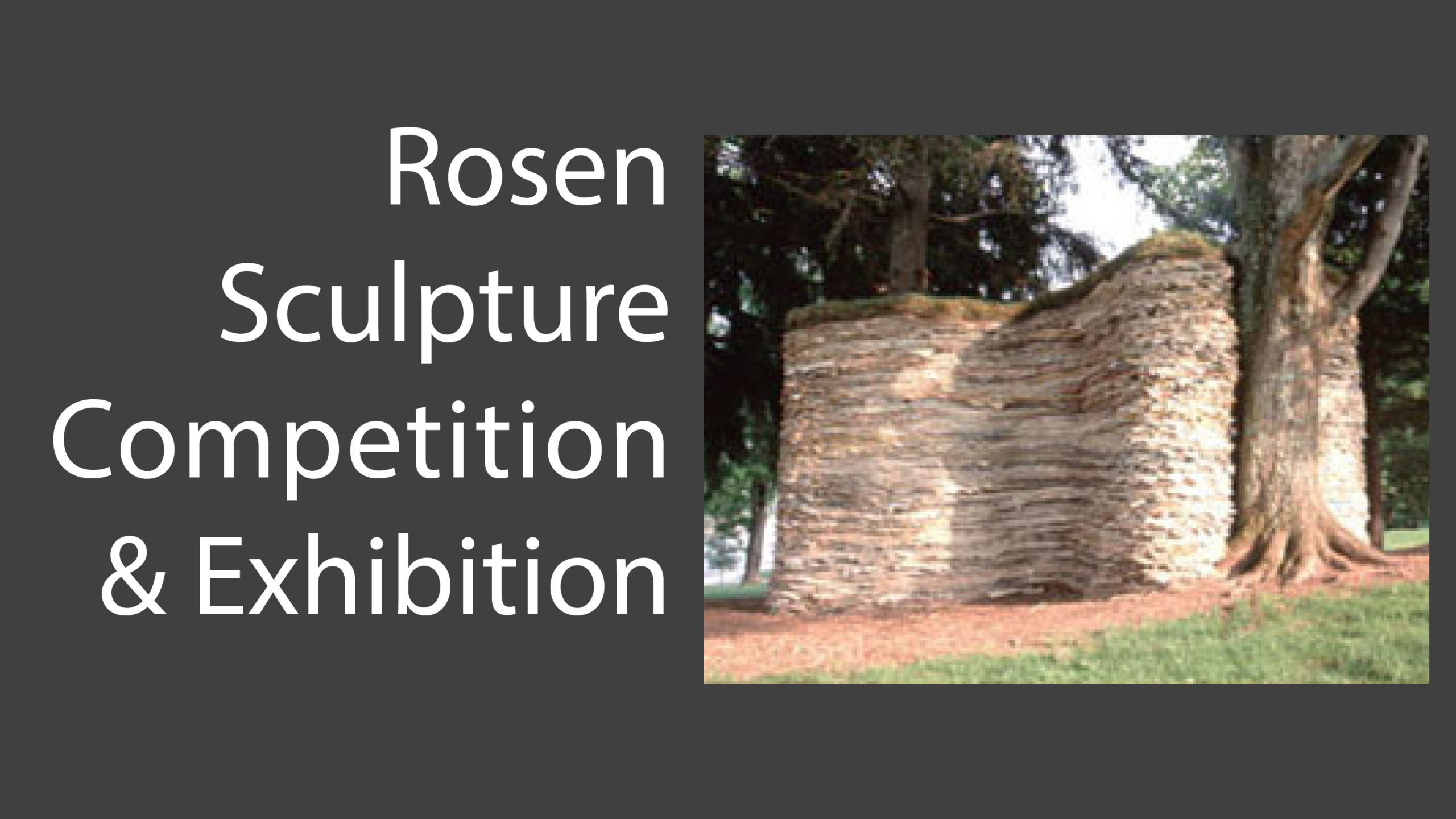
Steven Spiegel, Squeeze 2. 1998 / 12th Rosen Sculpture Competition Winner.
Sculptures
-
Squeeze 21st Place
Squeeze 2
Steven Siegel
Red Hook, New York
Newspaper, earth, and grass, Site specific.
Part of the Rosen Sculpture Loan Program
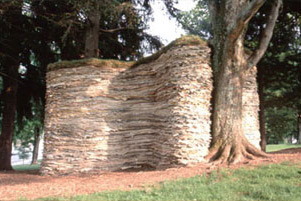
Artist statement
When I was a young boy, my family spent time during the summers at a beach house. A neighbor would sometimes come over on rainy days to entertain us by making trees out of rolled, telescoping newspaper. As I recall, they were replete with branches and leaves. The children were mesmerized. This memory just surfaced, and I doubt it has anything to do with my use of newspaper as a medium, but who knows? Anyway, being kind of old fashioned, I would like my work to stand on its own two visual feet. Interpretation is fine, but it shouldn’t come from me.
Juror’s Comments
Steven Siegel elected to start with a grove of trees. A seemingly solid mound or wall of newspapers interacts with the trees and slumps to fit the slope; the newsprint stratum is topped by turf, further uniting the piece with the environment. This, the most unusual artwork in the exhibition, makes gravity, geology, and even time visible.
Bird Catcher
Colin Beatty
Brooklyn, New York
Mixed media.
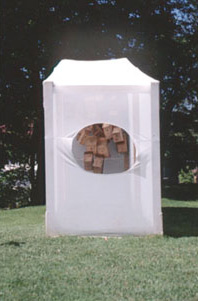
Artist statement
Scientific methodology is the point of departure for my work. Having been trained as a scientist, my work deals with the construction and presentation of scientific information. The works are representations of science not as truth, but as stories about the author as spokesperson for a culture.
My art work, then, has come to center around finding specific ways to explore the problem of scientific communication, to be directed at producing an alternative science, changing the priorities of science, and releasing the grips of contemporary scientific theories on our imaginations.
The placement of my work-in but somehow void of nature, about but refusing to give over describable data about the natural world, about the viewer’s body but also about the body’s depleted relevance in the physical world, narrating the subjectivity of the objective scientific experiment, is an attempt to deconstruct the boundaries of understanding through cumbersome, flawed binary systems (nature/culture, human/animal, organism/machine, art/science) returning us to and grounding us in our own bodies, both collective and individual. Hence my analysis of the construction and presentation of scientific information, my analysis through handmade tools and isolated, dissected ecosystems of experimentation, by exaggerating the miscommunication between culturally presented science and the natural and physical world, urges a rethinking of the dissemination of biological understanding.
Juror’s Comments
Colin Beatty’s beautiful Bird Catcher – beautiful but unusual in its combination ot tenting and bird houses – is artfully planted.
Chair for Ana M.
Amy Gerhauser
Norfolk, Virginia
Steel and iron.
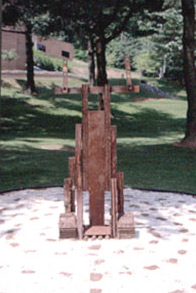
Artist statement
In my work I am exploring our physical and metaphysical relationship to nature via certain materials. primarily recycled iron and steel, as well as reclaimed wood and handmade paper, Iron especially interests me as a fundamental substance – in terms of our biological, cultural, and spiritual development. I have been working with the form of the chair, and more recently, the boat. Both objects indirectly allude to the physical body they enclose, support, bring one to the ground. My outdoor chair installations are intended to place the observer in direct contact with the earth, our matrix, both physically and conceptually. The humble scrap materials used in their construction, I-beams, railroad gussets, ingots, and rusted tools are in various states of decay, indicating iron’s eventual return to its common natural form, iron oxide. The found objects are used in a way to suggest an inversion of their association with technological progress and urban domination of the landscape, presenting instead an image of solitude, quiet, and reflection. The chairs are physically heavy, rooted, and grounded. Thus they function as anti-thrones The chairs conform to my physical scale, speak to the repetitive labor involved in their creation, and allow me to make space for myself as a woman within an historically masculine trade.
Some of my installations involve the image of the labyrinth. in a desire to present forms that signify balance via duality, I have found it necessary to work with the horizontal plane of the ground, activated by the verticality of the chairs. The labyrinth supports the idea of the chair as a site for transformation, countering a destination with a journey, masculine with feminine, lingam with yoni. Historically the labyrinth has been used as a practical tool as well as a metaphor for transformative ritual, as in the original meaning of the Greek myth of the Minotaur. I have represented this potent symbol as a hopeful invocation for positive change on an individual, private level.
Conduit
Steve Dolbin
Pomfret Center, Connecticut
Concrete.
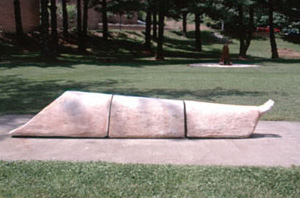
Artist statement
In the making of my work I seek to understand my life experience and creative compulsion. I have found much insight from my exploration of humanities bond with the land. The breadth of my work deals with the spiritual dialogue humans once had with the physical landscape and the more economic/resource oriented relationship that has come to dominate the present. Through my work of the past decade, I have tried to reveal some of the more enigmatic properties that exist in our kinship with our environment. I strive to connect my viewers with universal and intuitive feelings that are often dismissed. I try to accomplish this with works that recall ancient monuments and relics, yet are directly tied to the technology that has changed our planet’s surface and helped to form our present culture.
Material gleaned from our present day surroundings has played an important role in my work. The incorporation of mortal, synthetic and natural materials into my work has proven essential to my expression. For me these elements not only reflect our intrusion into geologic time but harken to our present urban existence.
Juror’s Comments
Steven Dobin’s Conduit, which seems to be a concrete figure rolled up in a concrete sleeping bag or body bag, is all the more poignant and perhaps frightening in the middle of a sloping lawn.
Confluence
Joseph Thompson
Athens, Georgia
Wood and steel.
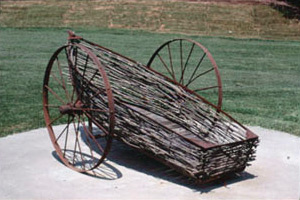
Artist statement
I see the piece, Confluence, as a juncture between physical form and conceptual realization. The form of a boat lends itself to associations concerning transience, security, and our own bodies. This boat however, is not a water-proof vessel nor a sea-worthy craft, instead it is a combination of anomalies, a woven hull, a wheeled boat, and an untethered anchor stone. These anomalies for me reflect the disparity of our own make-up. Our minds do not always work for the benefit of our body and certainly our spiritual entities are not always in touch with our physical existence. Finally, the idea of rapture is the idea for me that in spite of these anomalies there is always the chance for transcendence.
FS.922 Seven Steps to Nowhere
Rudy Rudisill
Gastonia, North Carolina
Galvanized steel.
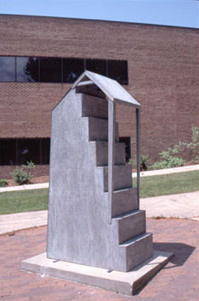
Artist statement
FS.922 Seven Steps To Nowhere is one of a group of sculptures I call “Public Buildings?” I recall the image of stairs that are hard or nearly impossible to climb and go nowhere from a reoccurring dream as a child, and later as a real place in a building where I once worked.
An interior space that is inaccessible, a staircase that leads to a blank wall with no door, no hand rails and steps that are narrow and steep … speculation on the meaning of these elements and the piece as a whole is truly the interactive part of this sculpture.
FS.922 is made of galvanized steel, with an interior framework of metal and is assembled using blind rivets. After construction, the piece was brushed with acid and allowed to weather for a short time. It was then rinsed and waxed.
About the artist
Born in Gastonia, North Carolina, Rudisill conjures a building lost and abandoned, excavating it from memory. The illusion of change arises via galvanized steel and copper brushed with acid, yielding a corrosive effect. The work is simultaneously contemporary and traditional, industrial and pastoral as Rudisill explores the relationship of physical elements to their symbolic implications. By bringing together various textures and architectonic forms, personal, cultural, and historical elements bind together in and homage to the changing landscape. Each anthropomorphic piece carries with it a narrative and a particular relationship—sometimes familial, other times structural. A working artist for over 25 years, Mr. Rudisill’s fabricated sheet metal sculpture has won international awards and can be found in public, corporate and private collections in North America, Europe, and Asia.
Juror’s Comments
Rudy Rudisill’s Seven Steps to Nowhere has just the right relationship to the nearby buildings in terms of echo and contrast.
Shakti
Gretchen Lothrop
Pittsboro, North Carolina
Steel.
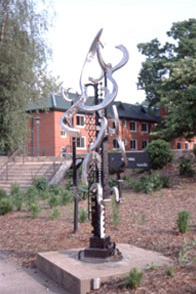
Artist statement
For a long time I thought my metal sculpture was a response to my obsession with music as many pieces seem to appear in the rear projection screen of my mind in response to particular pieces of music or memories of dance performances.
Recently, I realized that on a more fundamental level I am involved in a struggle to materialize time. What is time? A dynamic which gives meaning to music and, in fact, all processes. I think that my sculptures are an effort to freeze in an insistently “permanent” material like stainless steel, feelings which might otherwise be swept away by the mysterious river of time. I suppose that ultimately that makes the work simply another affirmation of life.
The Re Destruction of Karl Manzer’s Barn- Boone, North Carolina
Stephen Montague
Columbus, Ohio
Stone, wood, lead, and steel.
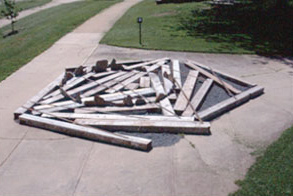
Artist statement
Boone is surrounded by trees, mountains and water. I used the byproducts of these mountains – timbers and stone. It would have been easy to have created a sculptural presence by standing the up, but I didn’t. In placing the timbers lying down, as if they were swept downstream in a logjam, I was able to use their combined surface to create an area upon which I could draw. I drew a landscape with stone, steel, lead and timbers.
Juror’s Comments
Stephen Montague’s ground-hugging piece made of timber, local slate and lead brings to life an odd island created by crossing paths.
Vestibule
David Tillinghast
Seneca, South Carolina
Steel.
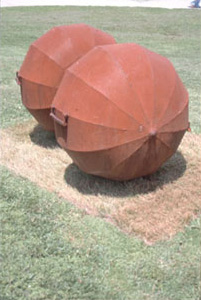
Artist statement
I have lived next to a body of water most of my life and I am drawn to the fluctuation of the shoreline … a kind of shelf where objects and environment are constantly rearranged. The boat hull, buoy, anchor, cable, steel, rust, erosion, dried lake bed, and the water’s edge where there is simultaneous uniformity and activity is the landscape from which my sculpture originates.
The act of carrying, balancing and transporting an unlikely vessel and cargo, while maintaining equilibrium, are central ideas in my work. I am aiming for an arena in which the human mind and body are at work in solving or making sense of a perplexing situation.
Vestigal Topographies
Cecilia Allen
Urbana, Illinois
Cast bronze.
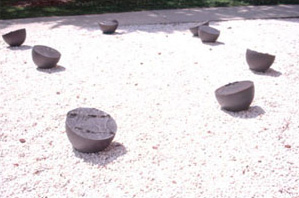
Artist statement
I am drawn to sculpture because it requires my whole being in its pursuit. It is tactile, visual, intellectual, emotional, psychological, spiritual. My work is an act of faith; an affirmation of the value of the arts in my life and contemporary culture. It is also an exorcism, an excavation of deep emotional and psychological effects. I seek content that is both personal and universal. My work concerns the things that afflict or redeem us all at a primal level: pain, hunger, joy, fear …. I seek to make sculpture that has the complex simplicity of a haiku. The form or language may be simple; the opus is not. As my work is ruled exclusively by neither passion nor reason, it is not intellectually contrived or emotionally effusive. In times of frustration in the studio, I have learned to look at what I have discarded. Solutions often lie in formerly repudiated materials, forms, or concepts. Such an approach leaves me open to discovery.
The intellect may at times dismiss or rebuff the very thing the spirit seeks. Faith, passion, and love are not functions of the intellect, but are integral parts of a whole person. Yin and yang; without darkness there is no light. The component elements of Vestigial Topographies derive their textures from the ground planes of work spaces. Random and unpremeditated, positive and negative, the textures are the result of the daily impact of the heat, sweat, and processes of making art. Some of the textures are rough and agitated, others are serene and meditative; they are lasting records that reflect the constant and changing struggle to learn, grow, and create.
About the juror
Well known arts professional John Perreault will serve as the juror for the 1998 competition, continuing the exhibition’s tradition of bringing nationally recognized arts professionals to An Appalachian Summer Festival. Mr. Perreault’s writings have appeared in Art in America, Artforum, Arts, and American Craft. Currently, he is the Executive Director of UrbanGlass, the New York Contemporary Glass Center in Brooklyn, New York.
Curator’s statement
Like all art media, contemporary outdoor sculpture pushes the boundaries implied by existing definitions. What does the category “outdoor sculpture” mean? First of all, and easiest to express, outdoor sculpture is out-of-doors. However, this obvious observation leads us to investigate many of the characteristics that make outdoor sculpture so wonderful.
Of first importance is the fact that outdoor sculpture really gets us where we live. On the college campus people are constantly moving from one building to another. This routine brings us in proximity to these works on a daily basis. This constant closeness provides us with numerous opportunities to experience the work. One might happen upon a new work and be instantly intrigued. Each time you pass the work, you reaffirm your relationship with the work – enjoying it even more over time. However, it is also possible that you might not “connect” with a work instantly, but over time subtleties become apparent and you begin to really experience the work. In either of these cases, or the range of experiences in between, outdoor sculpture becomes part of our environment. Being part of our environment means that our relationship with these works is affected by weather, time of day, season and our own mental and psychological placement. All of these factors contribute to a complex relationship that helps us challenge our creative and critical abilities, and our own definitions of art.
The next group of characteristics centers on the physicality of the work: they are form, scale, and materials. Form can be driven by many things – an investigation of the design elements, a ritual, a narrative, a response to the environment, the inherent qualities of materials, the contextual qualities of materials, or a combination of these and other concerns. The works in the Twelfth Rosen Outdoor Sculpture Competition & Exhibition offer an excellent opportunity to investigate the generation of form. In addition to the works, each artist has provided a statement which gives additional insight into their processes.
Linked with form is the characteristic of scale. For many years, a discussion of outdoor sculpture and scale led to one word – big. Large scale works act as magnets drawing people towards them often by the sheer gravity of their scale. However, most of these large scale outdoor sculptures were limited to monumental scale, mostly commissioned, artworks. The most important results of these large scale public sculpture programs were the sense of community engendered and the palpable excitement as people investigated and lived around these works. While the power of outdoor sculpture was immediately apparent, limitations severely narrowed the number of artists who could produce and show outdoor sculpture. Programs such as the Rosen Competition & Exhibition sought to provide venues for these sculptors and to bring the joys of public art to a wider audience.
This year’s exhibition includes the 120th sculpture placed on the Appalachian campus through the Rosen program. Not included in this number are the works purchased and installed as part of the permanent collection. Over the years, through the support of venues such as Appalachian, sculptors have experimented with the concept of scale as it relates to the outdoor environment. In the right setting, more human scale works can generate an intimate response. This response pulls viewers into investigating the work and offers insights because of the relationship between the scale of the work and the site. We are fortunate this year to have works which actively, and effectively, deal with the issue of scale. These works, with their varied sense of scale, offer us the opportunity to investigate how vital the scale is to our relationship with an artwork. As we move from the large works to the smaller works, it is interesting to imagine a reverse shift in scale. How might this affect our relationship with the work?
The final characteristic in this group is materials or media. Issues of scale, weather, and aesthetics combine to dictate the media for outdoor sculpture. However, just as artists have begun to play with scale, they have begun to play with the issue of appropriateness as it relates to materials. When many sculptures were monumental in nature, of course the materials had to support the structure. With changes in scale, the nature of materials has changed. Also, artists have begun to view nature/the environment as more of a collaborator in an evolutionary process of creation. For years artists have allowed the elements to patina metals, but in recent years artists have begun to use materials that undergo more intense physical reactions to the environment. Works may be designed for single exhibitions or may even be designed to decompose within a short period of time. The field of outdoor sculpture is no longer predominantly occupied by sculptors who only wish to create “permanent” works. This said, sculptors are more likely to be creating a combination of permanent and temporary works. It is this relationship – the exploration of materials and concepts – that has offered so much excitement to contemporary sculpture.
I am pleased and proud to offer this group of works to our community. We are indeed fortunate to have a program like the Rosen Outdoor Sculpture Competition & Exhibition, and the works in this year’s program provide a wonderful vignette of the exciting work that makes up contemporary sculpture. I invite you to join me in exploring, investigating, and enjoying this group of works. Each of these works brings us into the contemporary dialogue about sculpture and offers us a great opportunity for sharpening our critical and creative abilities.
Hank T. Foreman
Director & Chief Curator
Turchin Center for the Visual Arts
About the curator
Hank Foreman serves as Assistant Vice Chancellor of Arts and Cultural Affairs as well as Director and Chief Curator of the Turchin Center for the Visual Arts for Appalachian State University. He obtained his M.A. in Art Education from Appalachian, having completed undergraduate studies at the University of North Carolina at Charlotte, with a concentration in Painting and Sculpture. His duties include the administrative responsibilities for An Appalachian Summer Festival, the Performing Arts Series, Farthing Auditorium and the Turchin Center for the Visual Arts.
During his tenure at Appalachian State, Foreman has taken part in the organization of numerous exhibitions, including the associated lectures, symposia, and publications. He has worked closely with the university’s Department of Art, and a wide variety of other campus and community groups, to make gallery resources available to all. One of his earliest exhibitions at Appalachian, Views From Ground Level: Art and Ecology in the Late Nineties, brought internationally acclaimed artists, historians, and critics to the campus and received national attention.
Foreman is also an exhibiting studio artist, and participates in regional and national conferences as a presenter and panelist.
A Special Thanks from the Curator
On behalf of An Appalachian Summer Festival, the Office of Cultural Affairs, and the Catherine J. Smith Gallery, I wish to thank all of the artists who participated in this year’s competition and congratulate those chosen for the exhibition. I would like to thank our juror, John Perreault, for meeting the daunting task of choosing ten works from the over 250 works submitted. I wish to thank my colleagues in the Office of Cultural Affairs, my colleagues in the Art Department, and the students who participated in the installations. Special thanks for our designer- Mike Fanizza, photographer – Troy Tuttle, and Assistant to the Gallery Director – Kim Johnson McDade.
This year we were pleased to add the site-specific works category to the competition. Two works were completed on campus and I would like to take this opportunity to thank the following businesses for donations of materials: Blue Ridge Quarry, Timberframers of America, The Watauga Democrat, and Vulcan Quarry. Finally heartfelt thanks to Jim Bryan – Grounds Superintendent and crew, and to Evan Rowe – Safety Officer.
-Hank T. Foreman
